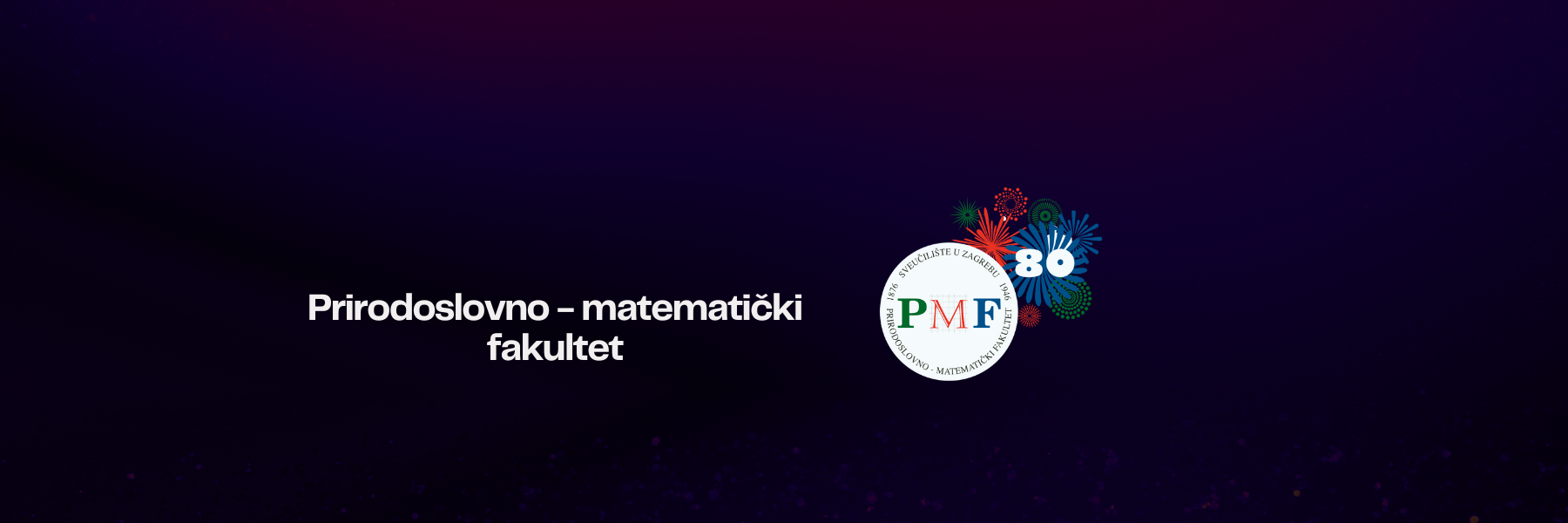.jpg)
Support: Croatian Science Foundation
Grant number: IP-2020-02-9932
Project duration: 18. 1. 2021. - 17. 6. 2025. (53 months)
Principal investigator: Marko T. Cvitaš
Project team members:
Nina Tokić
Mihael Eraković
Marin Sapunar
Ivan Ljubić
Marko T. Cvitaš
Nađa Došlić
Darko Babić
Brief description:
The goal of the project is to develop new computational methods for describing quantum nuclear effects in chemistry. Our approach is based on instanton theory and the emphasis is on studying the tunnel effect in molecular systems. In particular, we have generalized the method of Mil'nikov and Nakamura (J. Chem. Phys. 122, 124311, (2005)) to calculate tunnelling splittings in vibrationally excited states of molecules with multiple wells. We have also extended the formulation to include the wells that are asymmetric in shape and energy, and calculated tunnelling matrix elements due to coupling of inequivalent states on the opposite sides of the barrier [5]. The developed theory will be applied to study rearrangement dynamics of water clusters and its signature in the vibrational spectrum. We also aim to apply the instanton method in new contexts: to calculate nonadiabatic tunnelling rates of proton-coupled electron transfer reactions in aqueous media and tunnelling rates in some photo-excited systems.
Examples:
We have developed numerical algorithms for locating instanton paths and for increasing computational efficiency of the calculations of tunnelling splittings in molecules. The example below shows the located instanton path in malonaldehyde.
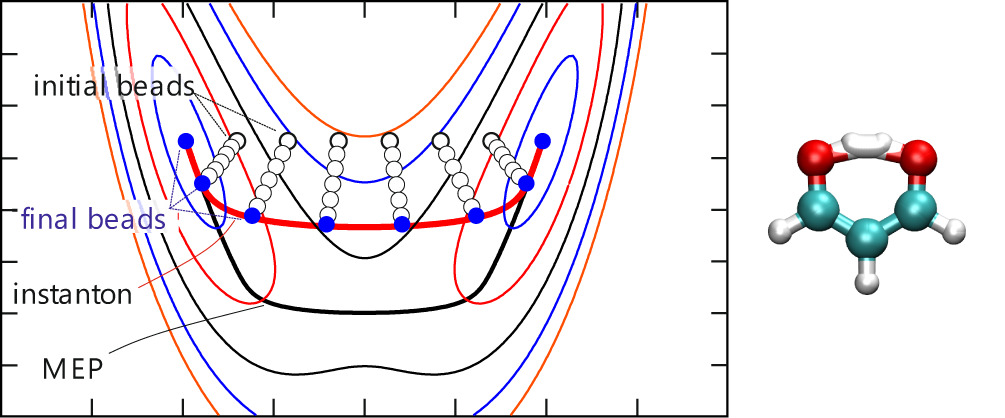
We have used instanton theory to explain the tunnelling splitting pattern of 320 states in the ground state of water pentamer, and interpreted it in terms of five rearrangements pathways (a simultaneous flip and bifuraction of hydrogen bonds is shown below).
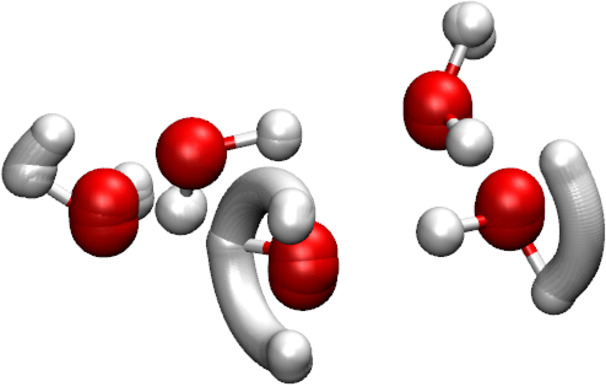
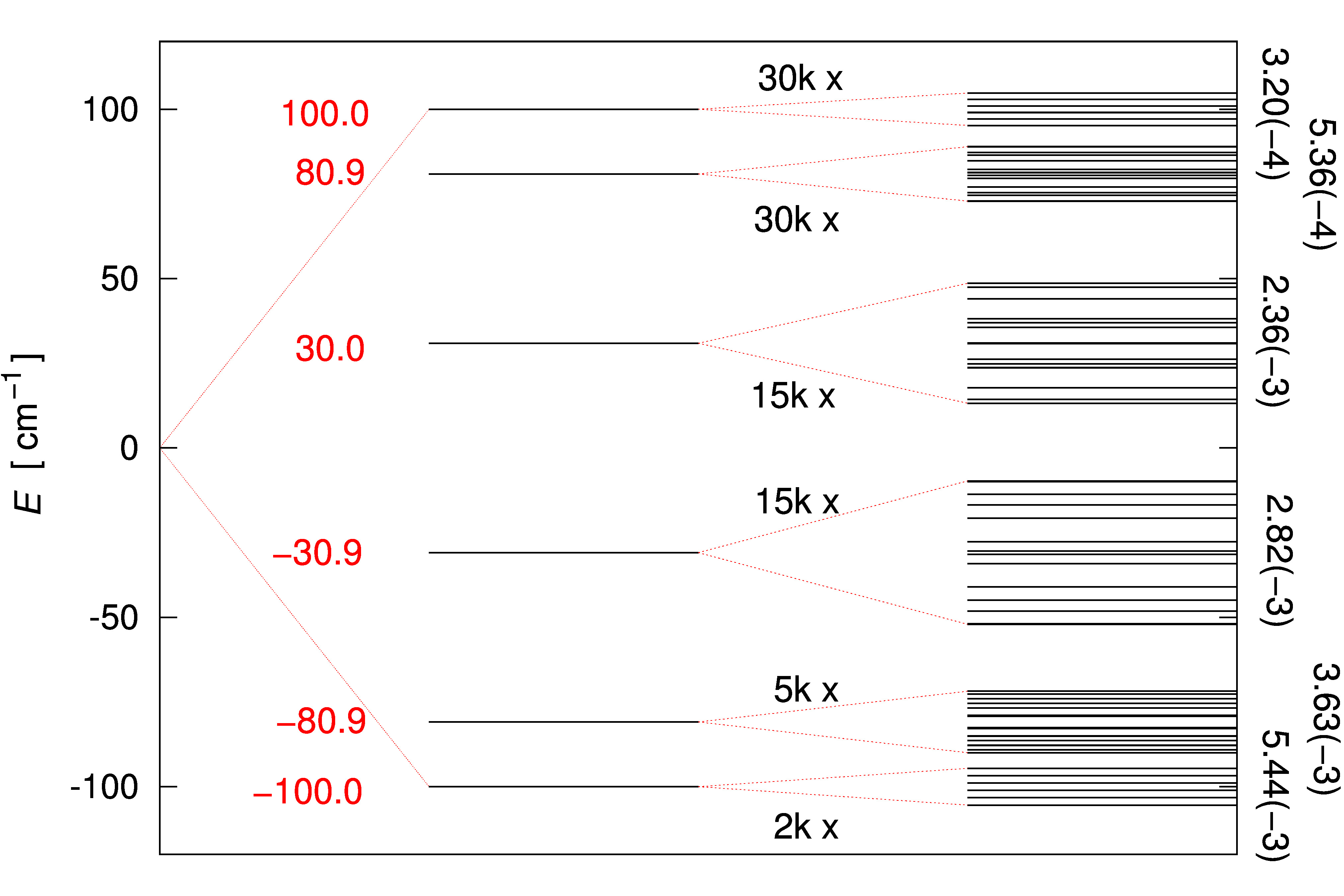
Recently, we calculated the low-lying vibrational tunnelling spectrum of partially deuterated malonaldehyde [5]. The system features asymmetry of the two wells due to zero-point energy difference and the calculation of tunnelling matrix elements between inequivalent states.
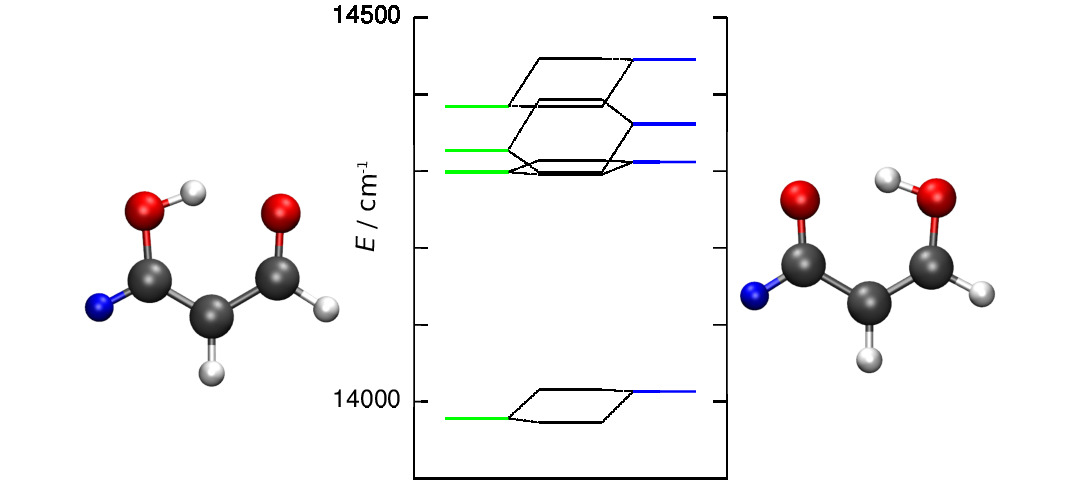
Main theoretical developments:
Multidimensional instanton theory for calculating tunneling splittings in the ground vibrational state was generalized to systems with multiple symmetry-related minima [1] and was shown to be equivalent to a modified WKB method (mWKB) [2]. m-WKB was used to extend the theory for calculating tunneling splittings in the vibrationally excited states [2] in the way that treats longitudinal and transverse vibrational modes on an equal footing, and thus allows for non-zero splittings in the excited modes that are longitudinal in one minimum and transverse in another. This allows one to apply the theory to calculate tunneling splitting patterns in, e.g., water clusters [5] and protonated water clusters [8]. We further modified and applied the theory to systems with inequivalent minima. This includes systems where a) minima differ in energy [3], b) minima differ in energy and potential [7], c) inequivalent states interact [4]. The theory was rederived using only Cartesian coordinates [6] and using propagation of Heller's wavepackets in imaginary time.
Publications:
[8] T. Babić, M. Eraković, M.T. Cvitaš, Croat. Chem. Acta 97, 2025-08-31 (2025).
[7] N. Tokić, M. Eraković, M.T. Cvitaš, Phys. Chem. Chem. Phys. 27, 6938-6957 (2025).
[6] M. Eraković, M.T. Cvitaš, J. Chem. Phys. 160, 154112 (2024).
[5] M. Eraković, M.T. Cvitaš, Phys. Chem. Chem. Phys. 26, 12965-12981 (2024).
[4] M. Eraković, M.T. Cvitaš, J. Chem. Theory Comput. 18, 2785-2802 (2022).
[3] M. Eraković, M.T. Cvitaš, Phys. Chem. Chem. Phys. 23, 4240-4254 (2021).
[2] M. Eraković, M.T. Cvitaš, J. Chem. Phys. 153, 134106 (2020).
[1] M. Eraković, C.L. Vaillant, M.T. Cvitaš, J. Chem. Phys. 152, 084111 (2020).
Full list of publications (acknowledged):
[1] Igor Sviben, Iva Džeba, Marija Bonifačić, Ivan Ljubić, Physical Chemistry Chemical Physics, 23, 10429, 2021.
[2] R. Totani, I. Ljubić, A. Clavardini, C. Grazioli, F. Galdenzi, M. de Simone, M. Coreno, Physical Chemistry Chemical Physics, 24, 1993, 2022
[3] J. Coonjobeeharry, K.E. Spinlove, C. Sanz Sanz, M. Sapunar, N. Došlić, G.A. Worth, Philososphical Transactions of the Royal Society A, doi: 10.1098/rsta.2020.0386
[4] M. Eraković, M.T. Cvitaš, Vibrational Tunneling Spectra of Molecules with Asymmetric Wells: A Combined Vibrational Configuration Interaction and Instanton Approach, J. Chem. Theory Comput. 18, 2785-2802, 2022
[5] Aurora Ponzi, Marin Sapunar, Nadja Došlić, Piero Decleva, Discrimination of Excited States of Acetylacetone through Theoretical Molecular-Frame Photoelectron Angular Distributions, Molecules 27, 1811 (12 str), 2022
[6] B. Milovanovic, J. Novak, M. Etinski, W. Domcke, N. Došlić, On the propensity of formation of cyclobutane dimers in face-to-face and face-to-back uracil stacks in solution, Phys. Chem. Chem. Phys. 24, 14836-14845, 2022
[7] J. Draženović, T. Rožić, N. Došlić, N. Basarić, Excited State Intramolecular Proton Transfer (ESIPT) from -NH2 to the Carbon Atom of a Naphthyl Ring, J. Org. Chem. 87, 9148−9156, 2022
[8] O. Travnikova, T. Piteša, A. Ponzi, M. Sapunar, R.J. Squibb, R. Richter, P. Finetti, M. Di Fraia, A. De Fanis, N. Mahne, M. Manfredda, V. Zhaunerchyk, T. Marchenko, R. Guillemin, L. Journel, K.C. Prince, C. Callegari, M. Simon, R. Feifel, P. Decleva, N. Došlić, M.N. Piancastelli, Photochemical Ring-Opening Reaction of 1,3-Cyclohexadiene: Identifying the True Reactive State, J. Am. Chem. Soc. 144, 21878−21886, 2022
[9] A. Ponzi, M. Rosa, G. Kladnik, I. Unger, A. Ciavardini, L. Di Nardi, E. Viola, C. Nicolas, N. Došlić, A. Goldoni, V. Lanzilotto, Inequivalent Solvation Effects on the N 1s Levels of Self-Associated Melamine Molecules in Aqueous Solution, J. Phys. Chem. B, 127, 3016−3025, 2023
[10] T. J. Wasowicz, I. Ljubić, A. Kivimäki, R. Richter, Core–shell excitation of isoxazole at the C, N, and O K-edges – an experimental NEXAFS and theoretical TD-DFT study, Phys. Chem. Chem. Phys. 24, 19302-19313, 2022
[11] V. Brusar, M. Forjan, I. Ljubić, M. Alešković, K. Becker, S. Vdović, Ultrafast photoelimination of nitrogen from upper excited states of diazoalkanes and the fate of carbenes formed in the reaction, J. Org. Chem. 88, 4286-4300, 2023
[12] M. Glavaš, K. Zlatić, D. Jadreško, I. Ljubić, N. Basarić, Fluorescent pH sensors based on BODIPY structure sensitive in acidic media, Dyes and Pigments 220, 111660 (), 2023
[13] N.Tokić, T. Piteša, A. Prlj, M. Sapunar, N. Došlić, Advantages and limitations of Landau-Zener surface hopping dynamics, Croat. Chem. Acta 97, 205-215 (2024)
[14] F. Agostini, S. Gomez, L. Ibele, A. Prlj, N. Došlić, M. Sapunar, et al, Roadmap for molecular benchmarks in nonadiabatic dynamics, J. Phys. Chem. A 129, 7023-7050 (2025)
[15] S. Coriani, N. Došlić, K.C. Prince, O. Plekan, et al, Unraveling the relaxation dynamics of uracil: insights from time-resolved X-ray photoelectron spectroscopy, J. Am. Chem. Soc. 2025, in print
[16] L.Mandić, I. Ljubić, I. Džeba, Time-resolved spectroscopic and computational study of the initial events in doxazosin photochemistry, Spectrochim. Acta A 306 123595 (2024)
[17] R. Totani, I. Ljubić, S.L. Mehl, V. Kalinovych, M. Jugovac, G. Bonano, A. Ciavardini, C. Grazioli, F. Galdenzi, S. D’Addato, M. de Simone, P.M. Sheverdyaeva, P. Moras, N. Tsud, M. Coreno, Evidence for efficient anchoring in nitroxyl radical thin films: an experimental XPS/NEXAFS and theoretical DFT/TD-DFT study, J. Mater. Chem. C 12, 6985 (2024)
[18] T.J. Wasowicz, M.K. Jurkowski, A.L. Harris, I. Ljubić, Unveiling the electron-induced ionization cross sections and fragmentation mechanisms of 3,4-dihydro-2H-pyran, J. Chem. Phys. 161, 064304 (2024)
[19] I. Ljubić, I. Sviben, V. Brusar, K. Zlatić, S. Vdović, N. Basarić, Competing Photocleavage on Boron and at the meso-Position in BODIPY Photocages, J. Org. Chem. 90, 259-274 (2025)
[20] M. Eraković, M.T. Cvitaš, Tunneling splittings in vibrationally excited states of water trimer, Phys. Chem. Chem. Phys. 26, 12965-12981 (2024)
[21] M. Eraković, M.T. Cvitaš, Tunneling splittings using modified WKB method in Cartesian coordinates: the test case of vinyl radical
[22] N. Tokić, M. Eraković, M.T. Cvitaš, Tunneling splittings in the energetically low-lying structural isomers of the water hexamer: the prism, the cage and the book, Phys. Chem. Chem. Phys. 27, 6938-6957 (2025)
[23] T. Babić, M. Eraković, M.T. Cvitaš, Tunneling Splittings of the Protonated Water and Water Dimer, Croat. Chem. Acta 97, 217-229 (2024)
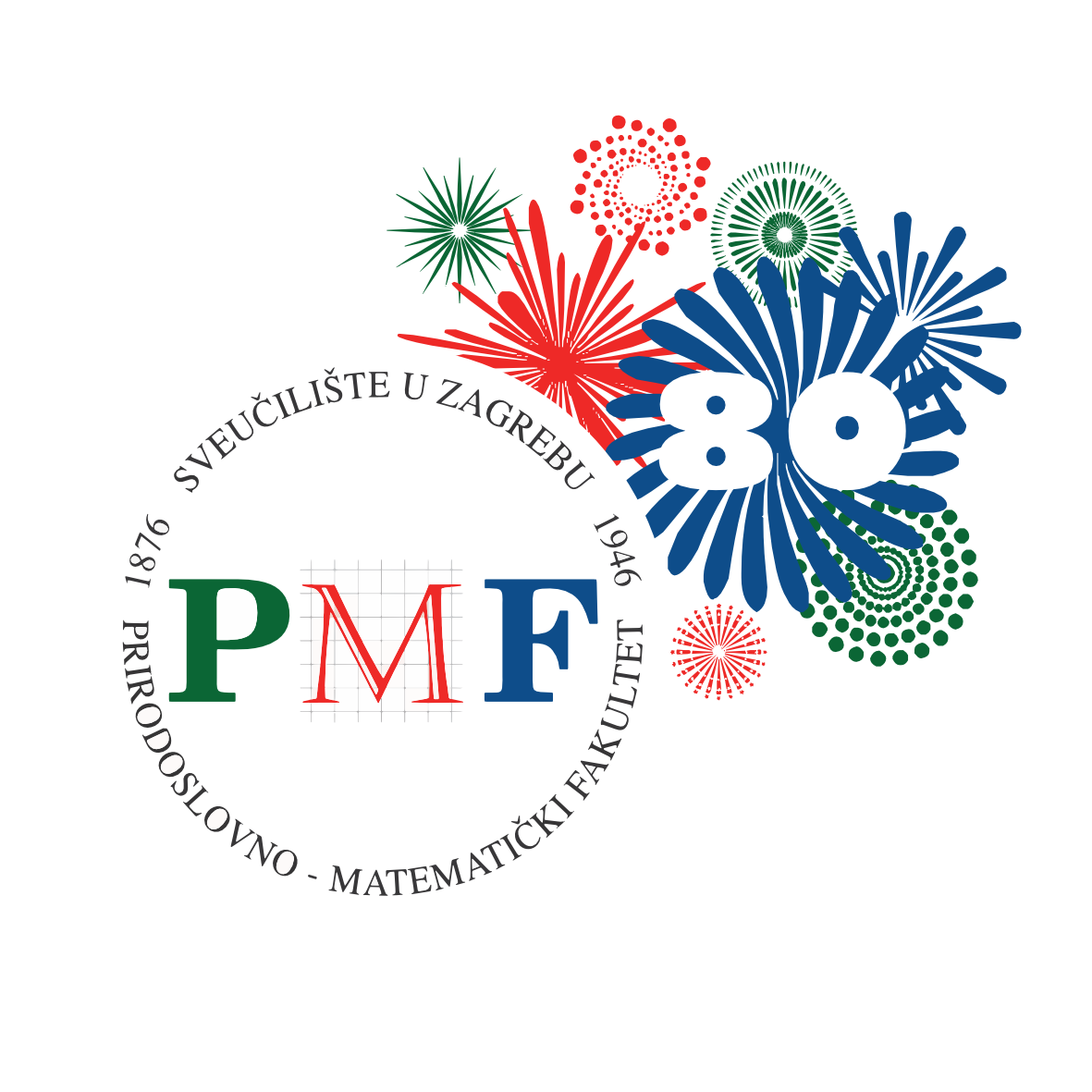
 Pristupačnost
Pristupačnost